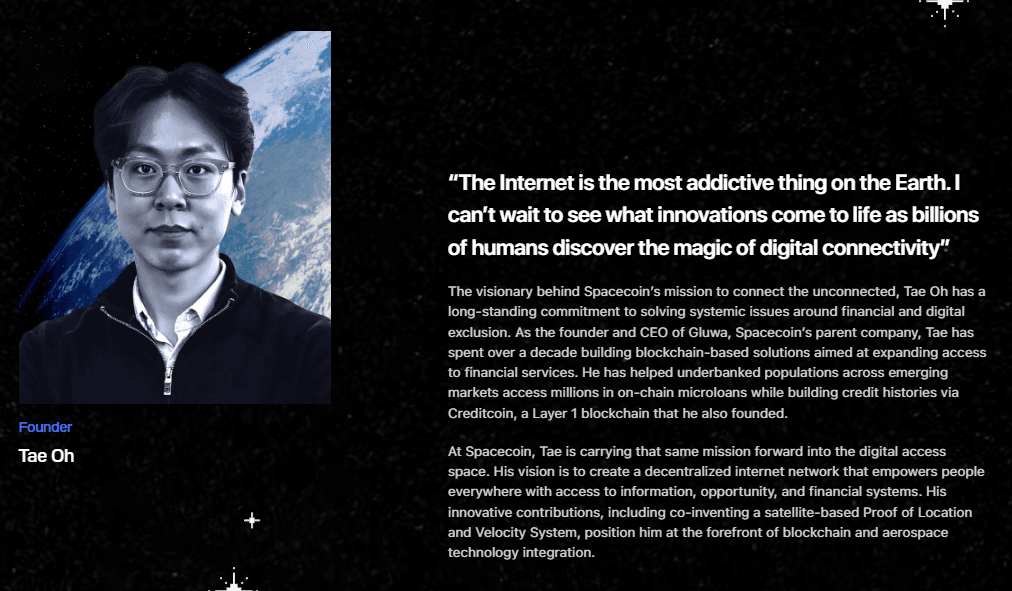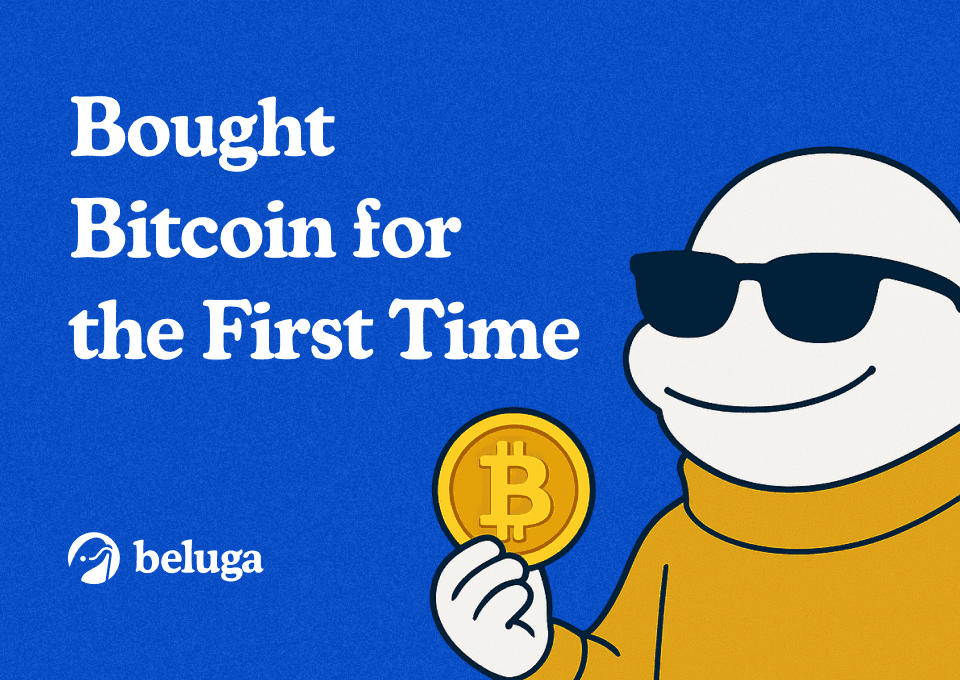Meet Spacecoin: The Starlink of Crypto, Now Live in Space
By Pratik Bhuyan Updated October 24, 2025

Summary
- Spacecoin is building a blockchain-powered satellite network to deliver affordable internet access to developing regions.
- The project has already launched its first operational satellite CTC-0, plans three more launches in Q4 2025.
- Founder Tae Oh, also behind Creditcoin, leads a team backed by aerospace experts like General Wesley Clark, combining blockchain & defense experience for rapid execution.
Introduction
If Starlink made the internet from space mainstream, Spacecoin might make it decentralized. What began as an ambitious vision to beam connectivity from the sky has already become a reality. The project has satellites in orbit, a growing launch schedule, and a clear mission: provide low-cost internet data to developing countries through a blockchain-powered satellite network.
Don’t mistake it for a sci-fi experiment because you can literally track Spacecoin’s live satellite in orbit right now using its real-time satellite tracker. And in Q4 of 2025, three more satellites will be hitching a ride on Falcon 9's Transporter-15 Rideshare rocket as part of the next wave of the network rollout.
The Mission: Internet for Everyone, Beamed from Space
Nearly 3 billion people worldwide still lack affordable internet access. Spacecoin’s mission is to bridge that gap by using low Earth orbit (LEO) satellites to deliver reliable, low-cost internet data across underserved regions.
The project’s open network can be used by telecom companies, governments, and even military organizations to operate or integrate their satellites, but a major focus is also on serving users in emerging markets who need reliable Internet access. Telcos can use Spacecoin’s satellites to expand rural or remote coverage, while governments can connect schools, hospitals, and defense infrastructure. In short, Spacecoin provides the backbone, and its partners bring the service to end-users.
![]()
Live tracking of CTC-0 satellite over Australia
Its model mirrors the strategy of SpaceX’s Starlink but focuses on cost efficiency and accessibility. Instead of high-priced subscriptions, Spacecoin’s system is designed to deliver connectivity for as little as $1-$2 per month in developing markets.
From Blockchain to Orbit
What makes Spacecoin special is not just its hardware but how it fuses space technology with blockchain. The network operates as a Decentralized Physical Infrastructure Network (DePIN) where satellites and ground nodes interact with an on-chain economy.
In October 2025, Spacecoin made history by completing the first end-to-end blockchain transaction routed through space. The message travelled from Chile to Portugal via its satellite CTC-0, orbiting roughly 500 kilometers above Earth. This proof of concept showed that blockchain data could move through orbit, marking a significant milestone in decentralized communication.
The underlying protocol also integrates a Proof of Location and Velocity mechanism (U.S. patent approved), ensuring that transmissions are verifiable and secure. Together, these systems lay the groundwork for decentralized communication and data validation directly from space.
Satellites in Orbit (and More Coming Soon)
Spacecoin’s first satellite, CTC-0, launched successfully in December 2024 via a SpaceX mission. It remains operational and can be tracked in real time on the project’s website.
The next batch, known as CTC-1, has already passed final health checks and will launch later this year, again using Falcon rockets. These three satellites will test satellite-to-satellite handoffs to demonstrate the network’s potential for scalable coverage expansion.
And that is only the start. The long-term vision is to build a global mesh network of satellites delivering affordable, censorship-resistant Internet access anywhere on Earth.
A Founder with Proven Blockchain Pedigree
Spacecoin’s founder, Tae Oh, is no newcomer to Web3. He previously created Creditcoin, one of the first blockchain networks focused on real-world credit access, and was part of the 500 Startups accelerator. Spacecoin is actually built on the Creditcoin ecosystem, showing that Tae has not left his earlier work behind but is continuing to expand and innovate on top of it. His experience at the intersection of fintech and frontier technology gives Spacecoin both credibility and vision.

Remaining optimistic about Spacecoin’s mission, Tae believes:
“Access to reliable Internet is as crucial today as access to education and resources. It sets you up for success in life and we are thrilled to be bringing that access to billions of people globally.
The project has also attracted notable advisors from the aerospace and defense world, including General Wesley Clark, a retired four-star U.S. Army general and former Supreme Allied Commander Europe of NATO. With decades of leadership in global infrastructure security, international strategy, and large-scale deployment, his experience adds immense strategic depth to the team. This mix of blockchain and aerospace expertise has allowed Spacecoin to move from concept to real orbital deployment faster than most expected.
Why Spacecoin Matters
While Starlink focuses primarily on direct consumer access, Spacecoin’s model is open and collaborative. The network can be integrated into existing telecom infrastructure, creating an ecosystem where decentralized internet becomes a layer available to multiple service providers.
Its blockchain base also enables financial inclusion. Users who access the network through Spacecoin-enabled devices can participate in the ecosystem’s on-chain economy, building a verifiable reputation and digital identity. In regions where traditional financial systems are inaccessible, connectivity becomes the first step toward digital participation.

As Spacecoin’s whitepaper explains, “Spacecoin is the world’s first decentralized physical infrastructure network (DePIN) powered by blockchain-enabled LEO nanosatellite constellations, positioned to become the standard open protocol for trustless internet connectivity on a global scale - connecting everyone and everything.”
Upcoming TGE and Community Engagement
Spacecoin’s Token Generation Event (TGE) is rumoured for Q4 2025, aligning with the upcoming satellite launch. The token will power the entire ecosystem, rewarding contributors who run ground nodes, provide bandwidth, and participate in network governance.
The team is also actively involving its community through two key initiatives: the Digital Testing Lab and the Airdrop Program.
Digital Testing Lab
Spacecoin's Digital Testing Lab is now open, offering participants the opportunity to observe live blockchain messages being routed through space via the CTC-0 satellite. This initiative allows community members to engage directly with the technology, providing valuable feedback and fostering a deeper connection with the project's mission.
Did You Know: For the next few days, until October 30th 2025, you can follow live blockchain messages transmitted through the CTC-0 satellite and claim a chance to win part of the $2,500 prize pool in SPACE tokens! Check their Medium post for more details.
Airdrop Program
The Spacecoin Airdrop Program is designed to reward early supporters of decentralized internet infrastructure. Participants can earn rewards by engaging with the project's ecosystem and contributing to its growth. You can learn more about it over here.
The Bigger Picture
Starlink revolutionized space-based connectivity, but Spacecoin aims to democratize it. Instead of one company owning the network, Spacecoin envisions a blockchain-coordinated constellation that anyone can interact with.
It represents a new category of DePIN projects, where physical infrastructure in orbit connects directly to digital value networks on Earth. The result is a hybrid of aerospace and crypto that could redefine how the next billion users come online.
In short, if Spacecoin succeeds, the implications are large: affordable global connectivity, new financial access for the un-banked, decentralised telecom infrastructure, and tokenised network economics.
If you enjoyed reading about Spacecoin till here, make sure to follow them on Twitter and stay updated with all the latest happenings!
Join the Beluga Brief
Dive deep into weekly insights, analysis, and strategies tailored to you, empowering you to navigate the volatile crypto markets with confidence.
Never be the last to know
and follow us on X








